Crew Photos – October 19th
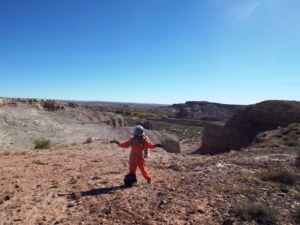
The Joy of Exploration

Jon on field
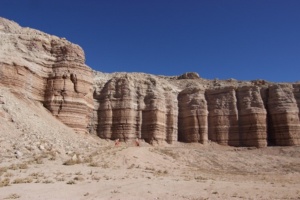
Jon and Anushree during eva in box canyon quarry
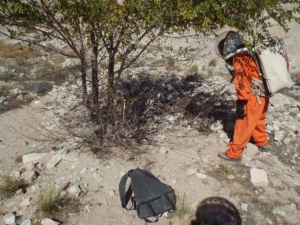
Exploring
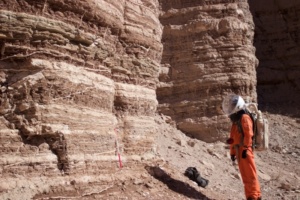
Dr. Jon Clarke during EVA
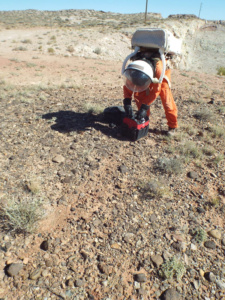
Anushree sampling

Anushree observing sampling site
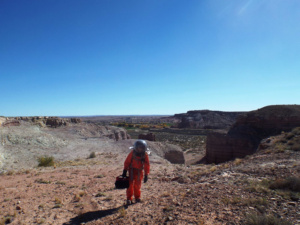
Anushree after sampling



The Joy of Exploration

Jon on field

Jon and Anushree during eva in box canyon quarry

Exploring

Dr. Jon Clarke during EVA

Anushree sampling

Anushree observing sampling site

Anushree after sampling
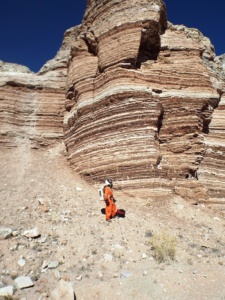
Claude-Michel Laroche
Mars 160 – Crew Engineer
Science Post
Sol 20 – Minutes spent during Science & Engineering Extra-vehicular
Activity (EVA) so far!
By Crew Biologist Anushree Srivastava
It is Sol 20, and after many strenuous extra-vehicular activities
performed by the MARS 160 crew at MDRS, it is worth documenting and
acknowledging how many minutes the crew spent performing rigorous
science and engineering extra-vehicular activities. Our Executive
Officer Yusuke Murakami did this exemplary job by generating this data
for individual crew members. So the entire crew spent 9119 minutes
outside the “Martian” vehicle under the scorching heat, in totality.
EVAs are physically demanding and sampling in full simulation suit
makes it even more challenging and painstaking. The crew carries
approximately 17-18 kg on their bodies when they egress the habitat in
total, including sampling tools and any extra baggage or gadget. With
this heavy weight, they reach difficult locations, they walk as well
as ride ATV on bumpy terrains, they climb the cliffs and slippery
mounds, they collect samples, and they generate the media to send back
to Earth. Although EVAs are challenging, they provide the crew with
the opportunity to actually demolish their wall of comfort and go out
to perform their respective mission activities. Sometimes, the crew
members get cross-trained on field to be able to replace the experts
when needed. EVAs are essential for the success of the mission
although they demand your sweat, thirst, and sometimes bruised bodies.
Individual Crew Members and the minutes they spent during EVAs:
Commander Dr Alex Mangeot 817 minutes 9.0 %
Crew Journalist Anastasia Stepanova 836 minutes 9.2 %
Crew Engineer Claude-Michel Lorche 1070 minutes 11.7 %
Health & Safety Officer Annalea Beattie 1317 minutes 14.4 %
Executive Officer Yusuke Murakami 1475 minutes 16.2 %
Crew Biologist Anushree Srivastava 1627 minutes 17.8 %
Crew Geologist Dr Jon Clarke 1977 minutes 21.7 %
Kudos to these “Martian” explorers! Many more EVAs to come!
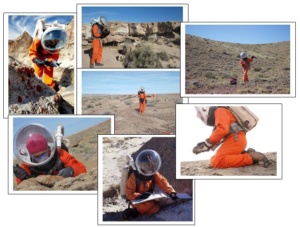
Figure: MARS 160 – Seven Analog Astronauts During EVAs!
Person filling out report: Anastasiya Stepanova
Summary Title: Pressurize Exploration Vehicle protocol test
Mission status: Operations are nominal
Sol activity Summary: The EVA crew went to Box Canyon Quarry using the habitat car and tested how it will be like on Mars. It is hard to get into the PEV in space suits, the car is too small and the suits are too big. The test failed. The rest of the crew was busy working on their projects: trying to make 3D printer work and beta version of SSUIt is operational. Physical activities, such as yoga, punctuated the evening. Looking forward to get the news about Sciaparelli lander.
Anomalies in work: No
Weather: Sunny, no wind, mild temperature
Crew Physical Status: Good
EVA: Gypsum, lichen sampling and hypolith finding
Cross Training in Cross Bedding
Post by: Annalea Beattie
How do we understand the relationships between grain size and current velocity in cross-bedded sandstone?
This afternoon we began cross training on features of the local sandstone geology with geologist Dr. Jon Clarke. We began with the nomenclature of physical sediments – the differences between sand and mud and clay and silt.
Jon defined anything above 2mm as gravel. 62 microns (a thousandth of a millimetre) to 2mm as sand, that’s grain size.
Less than 62 microns is silt and less than four microns is clay and both together are classified as mud. The eye stops seeing at 62 microns.
Clastic sediment is rock made up of fragments of older rocks. In terms of our local environment around the Mars Desert Research Station, it’s mostly made up of mudstone, (mudstone that breaks up into little pieces is called shale), and sandstone.
Viscosity is a significant factor is the way materials are transported. In a torrent racing down the mountain, coarse materials like big boulders and rocks are carried along by the high density of water. A lazy stream moves fine sand with little energy but cannot transport boulders or even coarse sand. The finer the grain size the lower the energy needed to move it.
Winds blow sand with ease, forming cross-bedded dunes in asymmetric shapes that typically steep (30-35 degrees). Dune sand grains are generally very well-rounded, compared to those in water-laid sediments. Water-formed cross-bedding are typically formed at angles of 10 to 20 degrees.
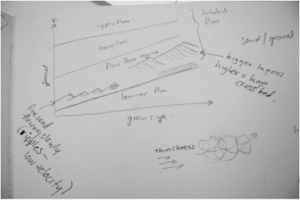
We can say that the shape of pebbles might tell us something about the way they have been formed and how far they have travelled. For instance, least travelled pebbles are often angular in shape. The rounder a rock is could mean it has been subject to abrasion in transportation- its edges erode through contact with other rocks and are smooth.
Sands grains, whether they are moved with air or water become sorted according to size and their shape and size changes. So size and grain shape also can indicate velocity and distance. But what if the rock is a very hard rock like a diamond ? It could travel a long way and not shatter or even get rounded.
The point is, to make observations in geology we need to combine a collection of basic principles and evidence in the field that is brought together to make a science narrative. Jon’s diagrams really helped us understand today’s’ session one of
cross-bedding cross-training. Session Two to follow.
Here is a main meal where Bacon is making the meal was is it. Is was lovely, delicious and could have so much more. The taste of bacon and mushroom cream on pasta was so fulfilling. Alexandre prepared this dish for us and we were expecting this and still we surprise and very eager to eat it.
Carbonara Spag: (for meat lover and good food lover all around )
Ingredients:
Half a Cup of hydrated mushroom / person,
1 Can of mushroom creme family size (640g),
1 Bag of bacon 375 g, (but the more the merrier)
1 ½ portion of spaghetti / person, and
Water for cooking the spaghetti and to hydrate the mushroom.
Note:
Step 1: Hydrate the mushroom with water in a mixing bowl.
Step 2: Open the bacon and cut each slices in square.
Step 3: Fry the squared bacon in pan until the fat start to beg for mercy,
Step 4: In the same pan add the whole can of family size mushroom
cream and the hydrated mushroom.
Step 5: In a big pan boil enough water for the amount of Spaghetti
you want to cook.
Step 6: Once the water is boiling, submerge the Spaghetti in the water.
Step 7: Once the Spaghetti is cooked, separated the pasta from the
water and put them in the pan with the carbonara sauce.
Step 8: Serve your guess without forgetting yourself with a bigger
portion of bacon.
This meal was one of our favorite meal because it tasted so good. It
is only too bad that we cannot have this meal everyday. The bacon
was a total delight, with mushroom creme nothing could have been
better for this meal. This meal is best serve with bread, ideally
french bread as is was Martio-french cooker who made it.
As always please try this at home. Very little supervision is
require, and to eat. Please enjoy.
Claude-Michel Laroche
Mars 160 – Crew Engineer
Here is a vegetarian main meal, directly form India featuring Toor
Dal and some Vegetables.
Great with a side dish of vegetables and rice. We had it with a mix
of slice potatoes, mushroom, green beans and some rice. As seen on
the picture.
Food Report for the 19th of October 2016.
Toor Dal soup of the day: (for 7 persons going on EVA and in need of energy)
Ingredients:
1 Cup of Toor Dal / person
1 Cup of water / person
Some Asafoetida
a pinch of salt
A handful of dried chopped onions
A handful of dried tomatoes
Note: You can add much vegetables that you want. The more the
merrier as they say.
Step 1: Add all the Toor Dal in a pressure cooker along with water
and a pinch of salt.
Step 2: Boil for 15 to 20 minutes.
Step 3: Add from butter ghee in a frying pan and heat on medium low.
Step 4: Add in the pan the vegetables and fry until the onion turn
brown, reserve.
Step 5: Once the Toor dal is cook, add it in the pan and mix thoroughly.
Step 6: Serve to eat.
This dish was very much appreciated by everyone, and has Dal so
can’t have too much of that right.
As always please try this at home. Very little supervision is
require, and to eat. Please enjoy.
Claude-Michel Laroche
Mars 160 – Crew Engineer